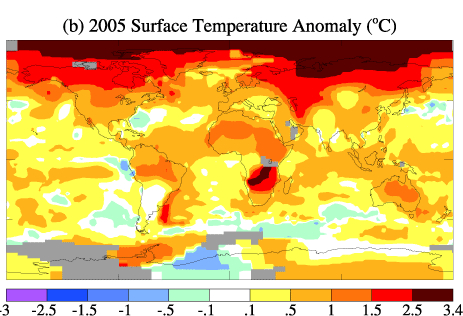Heads up: Plan for traffic and road closures this Sunday for Bay to Breakers.
Science News
Climate Change at the AGU
December 12, 2011

What can past climate tell us about future climate? How can one method of reporting current climate change help create consistent models? What the heck is climate sensitivity?
The answers (or beginning of them, anyway) were all included in a very in-depth press conference at the recent American Geophysical Union (AGU) meeting.
James Hansen of NASA Goddard is a well-known name in the climate change world. He has been talking about human influenced global warming since the 1980s. The pressroom was filled with reporters, I think in part because of his presence. He spoke about the paleoclimate history of ice sheets. He is pure science—delivering detailed facts via graph after graph, about how the ice sheets and vegetation influenced the climate millions of years ago, and how CO2 emissions, among other things, are influencing the climate now. Not surprisingly, the news is bad.
Hansen was joined by Eelco Rohling of Southampton University in the UK who discussed sea level change—both paleoclimate records and present-day. The key factor in both Hansen’s and Rohling’s presentations were how the adjustment of either the ice sheets or the sea levels take time, “likely millennia,” reported Rohling. That means that the damage we do today (without factoring future emissions) could take years and years and years to see.
Ken Caldeira of Stanford University gave a brief presentation that reconfirmed this fact. One of his graphs detailed that “climatically important amounts of carbon dioxide will remain in the atmosphere for thousands of years.”
Rohling and Caldeira both included definitions of climate sensitivity in their slides. Here is Caldeira’s:
Scientists estimate how much climate will change under conditions where some factors are allowed to vary and others are held constant.
This is important. Perhaps as important as the message of delayed cause and effect in climate that all touched upon.
Climate sensitivity is the reason that scientists results vary when talking about climate change. Hansen looked at ice sheets; Rohling, sea level rise. Another scientist could use ocean acidification or tropical ecosystems as a factor, Caldeira said, and the results would be different for obvious reasons. Climate sensitivity is the reason that politicians and the general public have trouble understanding climate change. Under different factors, there are different results. It's not black and white—given climate sensitivity, apples and oranges would be a better way to look at climate change.
Eelco Rohling agrees, and mentioned a new group he’s part of, the Paleosens working group. This group of scientists is hoping to create one way of reporting climate change—through one factor. "We need a common denominator to report this… There is enormous confusion, even among scientists on how to report this. As a community we're trying to create a framework so no matter how you report your study, you'll also report it this way." He stressed that none of the current climate studies is wrong, it's just a matter of reporting—what filter is the scientist looking through?
He even compared this common framework with the way taxonomists gather and share data! We reported on these methods just a few weeks ago!
This common framework will not be implemented/decided upon soon, Rohling warned. Will it work more efficiently in communicating climate change science to the public? It can't hurt.